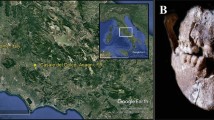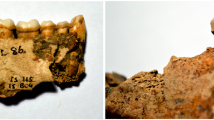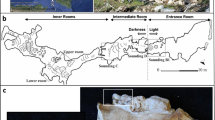Abstract
Remote Oceania, which largely consists of islands covered in tropical forests, was the last region on earth to be successfully colonized by humans, beginning 3,000 years ago. We examined human dental calculus from burials in an ancient Lapita culture cemetery to gain insight into the early settlement of this previously untouched tropical environment, specifically on the island of Efate in Vanuatu. Dental calculus is an ideal material to analyse questions of human and plant interactions due to the ingestion of plant-derived microparticles that become incorporated into the calculus as it forms throughout a person’s life. Most of the microparticles identified here are from tree and shrub resources, including a ~2,900 calibrated (cal) bp example of banana in Remote Oceania, providing direct evidence for the importance of forests and arboriculture during the settlement of Remote Oceania.
This is a preview of subscription content, access via your institution
Access options
Access Nature and 54 other Nature Portfolio journals
Get Nature+, our best-value online-access subscription
$29.99 / 30 days
cancel any time
Subscribe to this journal
Receive 12 digital issues and online access to articles
$119.00 per year
only $9.92 per issue
Buy this article
- Purchase on Springer Link
- Instant access to full article PDF
Prices may be subject to local taxes which are calculated during checkout



Similar content being viewed by others
Data availability
Images of photographed microparticles are available from the corresponding author on request.
References
Bailey, R. C. et al. Hunting and gathering in tropical rain forest: is it possible? Am. Anthropol. 91, 59–82 (1989).
Grollemund, R. et al. Bantu expansion shows that habitat alters the route and pace of human dispersals. Proc. Natl Acad. Sci. USA 112, 13296–13301 (2015).
Roosevelt, A. C. The Amazon and the Anthropocene: 13,000 years of human influence in a tropical rainforest. Anthropocene 4, 69–87 (2013).
Caetano Andrade, V. L. et al. Growth rings of Brazil nut trees (Bertholletia excelsa) as a living record of historical human disturbance in Central Amazonia. PLoS One 14, e0214128 (2019).
Bahuchet, S., McKey, D. & de Garine, I. Wild yams revisited: is independence from agriculture possible for rain forest hunter-gatherers? Hum. Ecol. 19, 213–243 (1991).
Mercader, J. Forest people: the role of African rainforests in human evolution and dispersal. Evol. Anthropol. Issues News Rev. 11, 117–124 (2002).
Wedage, O. et al. Specialized rainforest hunting by Homo sapiens ~45,000 years ago. Nat. Commun. 10, 739 (2019).
Roberts, P. et al. Direct evidence for human reliance on rainforest resources in late Pleistocene Sri Lanka. Science 347, 1246–1249 (2015).
Barker, G. et al. The ‘cultured rainforests’ of Borneo. Quat. Int. 448, 44–61 (2016).
Summerhayes, G. R. et al. Human adaptation and plant use in Highland New Guinea 49,000 to 44,000 years ago. Science 330, 78–81 (2010).
Barton, H., Denham, T., Neumann, K. & Arroyo-Kalin, M. Long-term perspectives on human occupation of tropical rainforests: an introductory overview. Quat. Int. 249, 1–3 (2012).
Roberts, P. & Petraglia, M. Pleistocene rainforests: barriers or attractive environments for early human foragers? World Archaeol. 47, 718–739 (2015).
Roberts, P., Hunt, C., Arroyo-Kalin, M., Evans, D. & Boivin, N. The deep human prehistory of global tropical forests and its relevance for modern conservation. Nat. Plants 3, 17093 (2017).
Summerhayes, G. R. et al. Tamuarawai (EQS): an early Lapita site on Emirau, New Ireland, PNG. J. Pac. Archaeol. 1, 62–75 (2010).
Rieth, T. M. & Athens, J. S. Late Holocene human expansion into Near and Remote Oceania: a Bayesian Model of the chronologies of the Mariana Islands and Bismarck Archipelago. J. Island Coast. Archaeol. 14, 5–16 (2017).
Petchey, F., Spriggs, M., Bedford, S. & Valentin, F. The chronology of occupation at Teouma, Vanuatu: use of a modified chronometric hygiene protocol and Bayesian modeling to evaluate midden remains. J. Archaeol. Sci. Rep. 4, 95–105 (2015).
Sheppard, P. J., Chiu, S. & Walter, R. Re-dating Lapita movement into Remote Oceania. J. Pac. Archaeol. 6, 26–36 (2015).
Bedford, S., Spriggs, M. & Regenvanu, R. The Teouma Lapita site and the early human settlement of the Pacific Islands. Antiquity 80, 812–828 (2006).
Kirch, P. V. On the Road of the Winds: An Archaeological History of the Pacific Islands before European Contact (Univ. California Press, 2017).
Rieth, T. & Cochrane, E. in The Oxford Handbook of Prehistoric Oceania (eds Cochrane, E. & Hunt, T.) 133–161 (Oxford Univ. Press, 2015).
Groube, L. M. Tonga, Lapita pottery, and Polynesian origins. J. Polyn. Soc. 80, 278–316 (1971).
Kinaston, R. L., Bedford, S., Spriggs, M., Anson, D. & Buckley, H. in The Routledge Handbook of Bioarchaeology in Southeast Asia and the Pacific Islands (eds Oxenham, M. & Buckley, H.) 427–461 (Routledge, 2016).
Kinaston, R. et al. Lapita diet in Remote Oceania: new stable isotope evidence from the 3000-year-old Teouma site, Efate Island, Vanuatu. PLoS One 9, e90376 (2014).
Crowther, A. Starch residues on undecorated Lapita pottery from Anir, New Ireland. Archaeol. Ocean. 40, 62–66 (2005).
Horrocks, M. & Bedford, S. Microfossil analysis of Lapita deposits in Vanuatu reveals introduced Araceae (aroids). Archaeol. Ocean. 40, 67–74 (2005).
Lentfer, C. J. & Green, R. Phytoliths and the evidence for banana cultivation at the Lapita Reber-Rakival site on Watom Island, Papua New Guinea. Records of the Australian Museum, Supplement vol. 29, 75–88 (2004).
Horrocks, M., Bedford, S. & Spriggs, M. A short note on banana (Musa) phytoliths in Lapita, immediately post-Lapita and modern period archaeological deposits from Vanuatu. J. Archaeol. Sci. 36, 2048–2054 (2009).
Kirch, P. V. Second millennium BC arboriculture in Melanesia: archaeological evidence from the Massau Islands. Econ. Bot. 43, 225–240 (1989).
Matthews, P. J. & Gosden, C. Plant remains from waterlogged sites in the Arawe Islands, West New Britain Province, Papua New Guinea: implications for the history of plant use and domestication. Econ. Bot. 51, 121–133 (1997).
Gosden, C. et al. Lapita sites of the Bismarck Archipelago. Antiquity 63, 561–586 (1989).
Lentfer, C. J., Matthews, P. J., Gosden, C., Lindsay, S. & Specht, J. Prehistory in a nutshell: a Lapita-age nut-cracking stone from the Arawe Islands, Papua New Guinea. Archaeol. Ocean. 48, 121–129 (2013).
Horrocks, M. & Nunn, P. D. Evidence for introduced taro (Colocasia esculenta) and lesser yam (Dioscorea esculenta) in Lapita-era (c. 3050–2500 cal. yr BP) deposits from Bourewa, southwest Viti Levu Island, Fiji. J. Archaeol. Sci. 34, 739–748 (2007).
Horrocks, M. & Bedford, S. Introduced Dioscorea spp. starch in Lapita and later deposits, Vao Island, Vanuatu. NZ J. Bot. 48, 179–183 (2010).
Horrocks, M., Nieuwoudt, M. K., Kinaston, R., Buckley, H. & Bedford, S. Microfossil and Fourier Transform InfraRed analyses of Lapita and post-Lapita human dental calculus from Vanuatu, Southwest Pacific. J. R. Soc. NZ 44, 17–33 (2014).
Matisoo-Smith, E. The commensal model for human settlement of the Pacific 10 years on—what can we say and where to now? J. Island Coast. Archaeol. 4, 151–163 (2009).
Valentin, F., Herrscher, E., Bedford, S., Spriggs, M. & Buckley, H. Evidence for social and cultural change in Central Vanuatu between 3000 and 2000 BP: comparing funerary and dietary patterns of the first and later generations at Teouma, Efate. J. Island Coast. Archaeol. 9, 381–399 (2014).
Worthy, T. H., Hawkins, S., Bedford, S. & Spriggs, M. Avifauna from the Teouma Lapita Site, Efate Island, Vanuatu, including a new genus and species of megapode. Pac. Sci. 69, 205–254 (2015).
Hawkins, S., O’Connor, S. & Kealy, S. Late Quaternary hominin-bat (Chiroptera) interactions in the Asia-Pacific. Archaeol. Ocean. 51, 7–17 (2016).
Collura, L. V. & Neumann, K. Wood and bark phytoliths of West African woody plants. Quat. Int. 434, 142–159 (2017).
Piperno, D. R. Phytoliths: A Comprehensive Guide for Archaeologists and Paleoecologists (AltaMira Press, 2006).
Vrydaghs, L. et al. Differentiating the volcaniform phytoliths of bananas: Musa acuminata. Ethnobot. Res. Appl. 7, 239–246 (2009).
Ball, T., Vrydaghs, L., Van Den Hauwe, I., Manwaring, J. & De Langhe, E. Differentiating banana phytoliths: wild and edible Musa acuminata and Musa balbisiana. J. Archaeol. Sci. 33, 1228–1236 (2006).
Lentfer, C. J. Tracing domestication and cultivation of banana phytoliths from phytoliths: an update from Papua New Guinea. Ethnobot. Res. Appl. 7, 247–270 (2009).
Castillo, C. & Fuller, D. Q. in The Oxford Handbook of the Archaeology of Diet (eds Lee-Thorp, J. & Katzenberg, M. A.) Chapter 10 (Oxford University Press, 2015).
Kennedy, J. Bananas and people in the homeland of genus Musa: not just pretty fruit. Ethnobot. Res. Appl. 7, 179–197 (2009).
Haberle, S. G., Lentfer, C., O’Donnell, S. & Denham, T. The palaeoenvironments of Kuk Swamp from the beginnings of agriculture in the highlands of Papua New Guinea. Quat. Int. 249, 129–139 (2012).
Fullagar, R., Field, J., Denham, T. & Lentfer, C. Early and mid Holocene tool-use and processing of taro (Colocasia esculenta), yam (Dioscorea sp.) and other plants at Kuk Swamp in the highlands of Papua New Guinea. J. Archaeol. Sci. 33, 595–614 (2006).
Denham, T. P. et al. Origins of agriculture at Kuk Swamp in the Highlands of New Guinea. Science 301, 189–193 (2003).
Vrydaghs, L. et al. in Phytolith and Starch Research in the Australian–Pacific–Asian Regions: The State of the Art (eds Hart, D. M. & Wallis, L. A.) 177–185 (Pandanus Books, Research School of Pacific and Asian Studies, The Australian National University, 2003).
Perrier, X. et al. Multidisciplinary perspectives on banana (Musa spp.) domestication. Proc. Natl Acad. Sci. USA 108, 11311–11318 (2011).
Kagy, V. et al. Traditional banana diversity in Oceania: an endangered heritage. PLoS One 11, e0151208 (2016).
Combettes, C. Les environnements du Vanuatu de l’Holocène à nos jours: un état des lieux des connaissances. Anthropologie 120, 175–208 (2016).
Spriggs, M. Early coconut remains from the South Pacific. J. Polynesian Soc. 93, 71–76 (1984).
Dowe, J. L. & Cabalion, P. A taxonomic account of Arecaceae in Vanuatu, with descriptions of three new species. Aust. Syst. Bot. 9, 1–60 (1996).
Tromp, M. & Dudgeon, J. V. Differentiating dietary and non-dietary microfossils extracted from human dental calculus: the importance of sweet potato to ancient diet on Rapa Nui. J. Archaeol. Sci. 54, 54–63 (2015).
Bourdy, G. & Walter, A. in Science of Pacific Peoples: Fauna, Flora, Food and Medicine (eds Morrison, J. et al.) 7–34 (Institute of Pacific Studies, 1994).
Walter, A. & Sam, C. Fruits of Oceania (Australian Centre for International Agricultural Research, 2010).
Buckley, H. R. et al. Scurvy in a tropical paradise? Evaluating the possibility of infant and adult vitamin C deficiency in the Lapita skeletal sample of Teouma, Vanuatu, Pacific islands. Int. J. Paleopathol. 5, 72–85 (2014).
Kinaston, R. L. et al. Investigating foetal and perinatal mortality in prehistoric skeletal samples: a case study from a 3000-year-old Pacific Island cemetery site. J. Archaeol. Sci. 36, 2780–2787 (2009).
Rudall, P. J., Prychid, C. J. & Gregory, T. Epidermal patterning and silica phytoliths in grasses: an evolutionary history. Bot. Rev. 80, 59–71 (2014).
Prasad, V. et al. Late Cretaceous origin of the rice tribe provides evidence for early diversification in Poaceae. Nat. Commun. 2, 480 (2011).
Minozzi, S., Manzi, G., Ricci, F., di Lernia, S. & Borgognini Tarli, S. M. Nonalimentary tooth use in prehistory: an example from early Holocene in Central Sahara (Uan Muhuggiag, Tadrart Acacus, Libya). Am. J. Phys. Anthropol. 120, 225–232 (2003).
Buckley, H. R., Tayles, N. G. & SpriggsM. J. T.. & Bedford, S. A preliminary report on health and disease in early Lapita skeletons, Vanuatu: possible biological costs of island colonization J. Island Coast. Archaeol 7, 87–1 (14 2008).
Valentin, F., Bedford, S., Buckley, H. R. & Spriggs, M. Lapita burial practices: evidence for complex body and bone treatment at the Teouma Cemetery, Vanuatu, Southwest Pacific. J. Island Coast. Archaeol. 5, 212–235 (2010).
Bedford, S., Spriggs, M., Buckley, H., Valentin, F. & Regenvanu, R. in Lapita: Ancestors and Descendants (eds Sheppard, P. J., Thomas, T. & Summerhayes, G. R.) 215–234 (New Zealand Archaeological Association, 2009).
Irwin, G. Pacific seascapes, canoe performance, and a review of Lapita voyaging with regard to theories of migration. Asian Perspect. 47, 12–27 (2008).
Finney, B. The other one-third of the globe. J. World Hist. 5, 273–297 (1994).
Finney, B. R. Voyaging canoes and the settlement of Polynesia. Science 196, 1277–1285 (1977).
Petchey, F., Spriggs, M., Bedford, S., Valentin, F. & Buckley, H. Radiocarbon dating of burials from the Teouma Lapita cemetery, Efate, Vanuatu. J. Archaeol. Sci. 50, 227–242 (2014).
Valentin, F., Spriggs, M., Bedford, S. & Buckley, H. Vanuatu mortuary practices over three millennia: Lapita to the early European contact period. J. Pac. Archaeol. 2, 49–65 (2011).
Bedford, S. et al. in Oceanic Explorations: Lapita and Western Pacific Settlement, Terra Australis Vol. 26 (eds Bedford, S. et al.) 223–240 (Australian National Univ. Press, 2007).
Bedford, S. & Spriggs, M. Birds on the rim: a unique carinated vessel in its wider context. Archaeol. Ocean. 42, 12–21 (2007).
White, A. W., Worthy, T. H., Hawkins, S., Bedford, S. & Spriggs, M. Megafaunal meiolaniid horned turtles survived until early human settlement in Vanuatu, Southwest Pacific. Proc. Natl Acad. Sci. USA 107, 15512–15516 (2010).
Constantine, A., Reepmeyer, C., Bedford, S., Spriggs, M. & Ravn, M. Obsidian distribution from a Lapita cemetery sheds light on its value to past societies. Archaeol. Ocean. 50, 111–116 (2015).
Galipaud, J.-C., Reepmeyer, C., Torrence, R., Kelloway, S. & White, P. Long-distance connections in Vanuatu: new obsidian characterisations for the Makué site, Aore Island: Makué obsidian. Archaeol. Ocean. 49, 110–116 (2014).
Reepmeyer, C., Spriggs, M., Bedford, S. & Ambrose, W. Provenance and technology of lithic artifacts from the Teouma Lapita Site, Vanuatu. Asian Perspectives 49, 205–225 (2011).
Tromp, M., Buckley, H., Geber, J. & Matisoo-Smith, E. EDTA decalcification of dental calculus as an alternate means of microparticle extraction from archaeological samples. J. Archaeol. Sci. Rep. 14, 461–466 (2017).
Dobney, K. & Brothwell, D. A method for evaluating the amount of dental calculus on teeth from archaeological sites. J. Archaeol. Sci. 14, 343–351 (1987).
ICPT. International Code for Phytolith Nomenclature (ICPN) 2.0. Ann. Bot. 124, 189–199 (2019).
Acknowledgements
The research presented here was funded by a University of Otago Doctoral Scholarship, a Royal Society of New Zealand Skinner Fund grant and an Otago Centre for Electron Microscopy Student Research Award awarded to M.T. We thank J. Dudgeon for giving M.T. access to the scanning electron microscope at Idaho State University and the Department of Anthropology and Archaeology at the University of Otago for providing access to their light microscopes. Further work on the manuscript was supported by the Max Planck Society. We thank P. Roberts and N. Boivin for their comments on a previous manuscript. We thank J. Maxwell for creating the map and J. Hurford for help creating all other figures. We thank C. Sam and F. Alo from the Department of Forestry in Port Vila, K. Allen and S. Alben and numerous chiefs and villagers from Efate Island and northeast Malakula who helped to collect the reference material, as well as C. Stantis who collected additional material from Atiu, Cook Islands. We also thank R. Shing and M. Abong of the Vanuatu Cultural Centre (VCC) for their assistance during calculus sampling. Sampling was done through a research agreement with the Vanuatu National Cultural Council. The Teouma Archaeological Project is a joint initiative of the Vanuatu National Museum and the Australian National University (ANU), directed by M.S. and S.B. and at different times R. Regenvanu and M. Abong, both former Directors of the VCC. Funding of the project was provided by the Australian Research Council (grant no. DP 0556874), the National Geographic Society (grant no. SRC 8038–06), the Pacific Biological Foundation, the Department of Archaeology and Natural History and School of Archaeology and Anthropology at the ANU, the Snowy Mountains Engineering Corporation Foundation and B. Powell. The laboratory research and travel for excavation of the skeletal remains were funded by The Royal Society of New Zealand Marsden Fund (grant nos. UOO0407 and 09-UOO-106) and a University of Otago Research Grant awarded to H.B. The support of the leaseholder M. R. Monvoisin and family is acknowledged, as is the support and assistance of the traditional landowners and population of Eratap Village. The funders had no role in study design, data collection and analysis, decision to publish or preparation of the manuscript.
Author information
Authors and Affiliations
Contributions
M.T. wrote the paper, designed the study, performed the analyses and analysed the results. L.M.-S. edited the paper and was involved in project planning. R.K. conducted the field work, wrote the paper and provided reference material. S.B. and M.S. conducted the field work, provided the samples and edited the paper. H.B. conducted the field work, wrote the paper, designed the study and was involved in project planning.
Corresponding author
Ethics declarations
Competing interests
The authors declare no competing interests.
Additional information
Peer review information Primary Handling Editor: Stavroula Kousta
Publisher’s note Springer Nature remains neutral with regard to jurisdictional claims in published maps and institutional affiliations.
Supplementary information
Supplementary Table
Supplementary Tables 1–3.
Rights and permissions
About this article
Cite this article
Tromp, M., Matisoo-Smith, E., Kinaston, R. et al. Exploitation and utilization of tropical rainforests indicated in dental calculus of ancient Oceanic Lapita culture colonists. Nat Hum Behav 4, 489–495 (2020). https://doi.org/10.1038/s41562-019-0808-y
Received:
Accepted:
Published:
Issue Date:
DOI: https://doi.org/10.1038/s41562-019-0808-y
This article is cited by
-
Environmental implications and evidence of natural products from dental calculi of a Neolithic–Chalcolithic community (central Italy)
Scientific Reports (2021)
-
Temporal trends in the Colonisation of the Pacific: Palaeodemographic Insights
Journal of World Prehistory (2021)
-
Isotopic evidence for initial coastal colonization and subsequent diversification in the human occupation of Wallacea
Nature Communications (2020)



